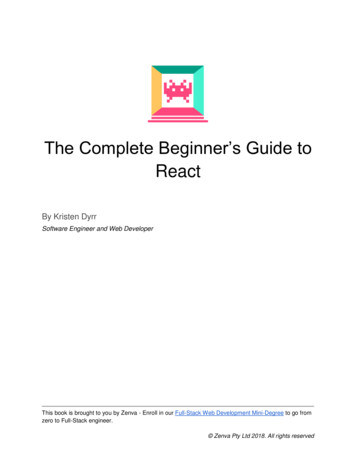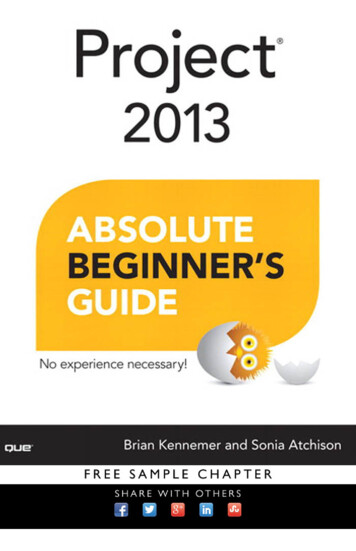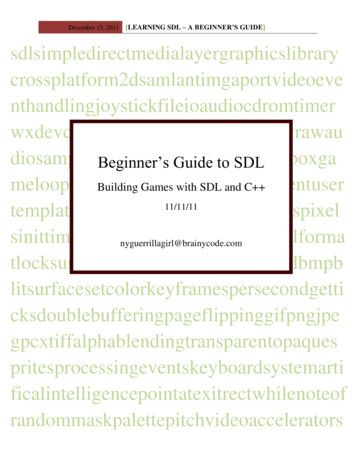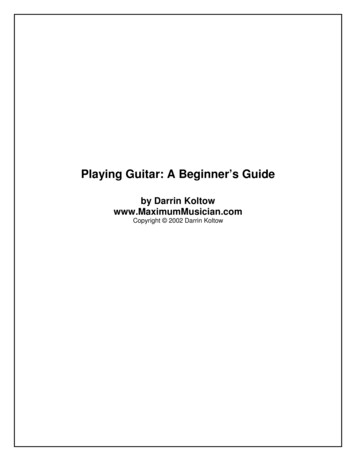
Transcription
The Complete Beginner’s Guide toReactBy Kristen DyrrSoftware Engineer and Web DeveloperThis book is brought to you by Zenva - Enroll in our Full-Stack Web Development Mini-Degree to go fromzero to Full-Stack engineer. Zenva Pty Ltd 2018. All rights reserved
Table of ContentsChapter 1: Beginner’s Guide to React.js, With ExamplesDownload the source codeLearn React onlineTutorial requirementsDownloading React and getting startedWhy React is better with JSXUnderstanding React componentsReact component statesHow to use propsOrganizing your interfaceChapter 2: Form Validation Tutorial with React.JSDownload the source codeTutorial requirementsGetting started with the tutorialSetting up for form submissionCreating abstract form elementsCreating input fieldsChapter 3: How to Submit Forms and Save Data with React.js and Node.jsDownload the tutorial filesTutorial requirementsMaking revisions to a React user interfaceDisplaying new data from everyoneSubmitting form dataEmptying fields on form submissionSaving data to the serverChapter 4 Creating a Crossword Puzzle game with React.JSDownload the source codeTutorial requirementsIntro to JSFiddleDownloading ReactDefining ComponentsRendering ComponentsPopulating PropsPopulating Properties in the GameComposing ComponentsEventsFormsThis book is brought to you by Zenva - Enroll in our Full-Stack Web Development Mini-Degree to go fromzero to Full-Stack engineer. Zenva Pty Ltd 2018. All rights reserved
Chapter 1: Beginner’s Guide to React.js, WithExamplesReact.js is a JavaScript library that was created by Facebook. It is often thought of as the “view”in a model-view-controller (MVC) user interface. This makes sense when you consider the factthat the only function that must be implemented in React is the “render” function. The renderfunction provides the output that the user sees (the “view”).Let’s take a look at why you may want to use React and how to set up a basic interface.Download the source codeYou can download all of the files associated with this tutorial from here.Learn React onlineIf you are keen to learn React from the ground-up feel free to check Learn and UnderstandReact JS on Zenva Academy which covers all the basics lots of bonus topics like ReactRouter and Flux.Tutorial requirements This tutorial assumes that you have at least a beginner’s grasp of HTML and JavaScript. You will need to download the React library if you want to go beyond the testing phase.We show you how to get around this during testing. You will need a text editor of some sort. Notepad is popular for those on Windowsmachines, and TextMate is popular on a Mac. Editors that highlight code are preferable. Normally, you would incorporate React into a larger application. If you want to test thebasic code with external data files at the end of the tutorial, you will need to use a localor remote web server to get the page to work. MAMP is popular on Mac, and WAMP ismost common on Windows machines. You can also use a lightweight Mongoose webserver, or Python’s HTTP server. Many people use React with Node.js, so you can alsouse a Node.js server. The React library download page (above) also includes a serverand other options.This book is brought to you by Zenva - Enroll in our Full-Stack Web Development Mini-Degree to go fromzero to Full-Stack engineer. Zenva Pty Ltd 2018. All rights reserved
Downloading React and getting startedThere are many options for downloading and installing React and its various add-ons, but thefastest way to get started and begin playing around with React is to simply serve the JavaScriptfiles directly from the CDN (as described on the React GitHub page the most common CDNoptions are listed there):Both the download pages go into detail on the various ways to download, install, and serveReact in various formats, but we’re going to stick with this most basic option so we can focus onlearning how to code with the React library itself. It’s a good idea to have the React API openwhile you work for reference.From there, we create an index.html file, and a main.js file. I’ve also included a css file for basicstyling:In order to get around using a server while testing, I’m calling the React.js, react-dom.js, and thebrowser.min.js babel-core files from the CDN. You wouldn’t want to do this in production. Thebabel-core file allows us to use JSX, and the script type must be “text/babel” in order for it towork properly. Our main JavaScript code goes in main.js, and that’s where it all starts.This book is brought to you by Zenva - Enroll in our Full-Stack Web Development Mini-Degree to go fromzero to Full-Stack engineer. Zenva Pty Ltd 2018. All rights reserved
Why React is better with JSXMost React implementations make use of JSX, which allows you to put XML-like syntax rightwithin JavaScript. Since React displays output as it’s main function, we will be using HTML injust about every component. JSX simplifies the code that would normally have to be written inJavaScript, which makes your code much more readable and simplified.JSX is not required, but consider the difference between two very simple statements. Thefollowing statement is created without JSX:The following is with JSX:As you can see, the JSX code is much easier to read. Now that we have a basic understandingof what our output syntax will look like, let’s dig in and learn the building blocks of React.Understanding React componentsReact is based on components and states. This is what makes React such a popular library.When you want to create an application, you usually break it into simpler parts. Whenprogramming with React, you will want to break your interface into its most basic parts, andthose will be your React components.Components are wonderful because they are modular and reusable. You can take a basiccomponent used in one area of an application and reuse it in others without having to duplicatecode. This helps to speed up development.Components can be nested, so that the most basic components can be grouped into a parentcomponent. For example, if you were to create a home listing interface with React, the top levelcomponent would be the home list itself. Within the list, you would have a description of a singlehome. Within the home component, you would have the address of the home, as well as othersmall components such as a photo, perhaps a favorite or save button, and a link to view detailsand a map.This book is brought to you by Zenva - Enroll in our Full-Stack Web Development Mini-Degree to go fromzero to Full-Stack engineer. Zenva Pty Ltd 2018. All rights reserved
Now let’s see how this information can be updated when it changes.React component statesComponent states are what give React its name. Any time a component’s state changes, its“render” function is called, updating the output. In essence, each component “reacts” tochanges, which is handy for any user interface. Data stored in a state should be information thatwill be updated by the component’s event handlers (changes that should update in real time asthe interface is being used).If we were to have a home listing, any number of things may change in the database. Newphotos could be added, and a home can be bought and sold. You wouldn’t necessarily want anyof these things to update in real time in the interface.One thing that may change very quickly, however, would be the number of times a home issaved (or favorited or liked) by a user. The little component that displays the number of savesThis book is brought to you by Zenva - Enroll in our Full-Stack Web Development Mini-Degree to go fromzero to Full-Stack engineer. Zenva Pty Ltd 2018. All rights reserved
could update as soon as the person clicks the Save button by updating the state the momentthe button is clicked. Let’s build the Saves component to show what this would look like:This book is brought to you by Zenva - Enroll in our Full-Stack Web Development Mini-Degree to go fromzero to Full-Stack engineer. Zenva Pty Ltd 2018. All rights reserved
This book is brought to you by Zenva - Enroll in our Full-Stack Web Development Mini-Degree to go fromzero to Full-Stack engineer. Zenva Pty Ltd 2018. All rights reserved
This won’t actually do anything yet, because we don’t have any statement to call on Saves. Still,this component describes what we do with components and states. You also won’t find thiscode anywhere in the files, because we will have to move things around a bit to make it workthe way we want, but this is fine for now.You may notice a naming convention right away. Most element names start with a lowercaseletter, followed by capitalization. The names of React classes, however, begin with anuppercase letter. We then have the React.createClass() function, which creates our component.The render method is that most-important method that produces the actual output, and isnormally placed last in the component. As you can see, the output depends on the value of twostates: saved and numSaves. Here’s what the output will look like when the user has saved thehome:And when they have not saved the home:Just don’t include computed data in a state. What that means in this case is that, while you wantto update the number of saves in the state when the Save button is clicked, you don’t want tosave the following in the state:Save the addition of the string for the render function. All we want to save in the state is the datathat gets updated by the component’s event handler, and that is simply the number of favorites.You can also see JSX at work in the render method. The return value (just don’t forget theparentheses around the return output!) appears to be just regular HTML right within yourJavaScript code! Well, not exactly. JSX is JavaScript, so the “class” attribute is discouraged.Instead, use “className.” In addition, JavaScript expressions used as attribute values must beenclosed in curly braces rather than quotes.Because we are dealing with states, we need to set an initial state so that the state variables willalways be available in the render method without errors. This is why we use the getInitialState()method at the top of the component.This book is brought to you by Zenva - Enroll in our Full-Stack Web Development Mini-Degree to go fromzero to Full-Stack engineer. Zenva Pty Ltd 2018. All rights reserved
The handleSubmit function is where we handle the pressing of the Save (or Remove) button.We first have to call preventDefault() in order to prevent the form from being submitted thenormal way. We then process the data, so that the user will save the home if it’s not alreadysaved, or remove it from their saves if it is saved. As soon as we save the new state at the endof the function, the render method will be called automatically, which will update the display.Now, let’s look at the rest of the example in more detail.How to use propsComponents pass properties to their children components through the use of props. One thingto keep in mind is that props should never be used to determine the state of a component. Aproperty would be something such as the address of a home, passed from the listingcomponent to the individual home component. The state, on the other hand, should depend ondata that may be updated, such as the number of times people have saved the home.Let’s look at the rest of this basic example. Taking into account the proper use of props andstates, you may notice that there are some problems with this code:This book is brought to you by Zenva - Enroll in our Full-Stack Web Development Mini-Degree to go fromzero to Full-Stack engineer. Zenva Pty Ltd 2018. All rights reserved
This book is brought to you by Zenva - Enroll in our Full-Stack Web Development Mini-Degree to go fromzero to Full-Stack engineer. Zenva Pty Ltd 2018. All rights reserved
This book is brought to you by Zenva - Enroll in our Full-Stack Web Development Mini-Degree to go fromzero to Full-Stack engineer. Zenva Pty Ltd 2018. All rights reserved
For this basic example, we are just going to hard-code a home listing. It all starts at the bottom,where we have the ReactDOM.render() call. Version 0.14 of React separated React into twomodules: React and ReactDOM. ReactDOM exposes DOM-specific methods, and Reactincludes the core tools shared by React on different platforms. HomeListing / is basically acall to a component, in XML-style code. The naming convention states that regular HTML codeis lowercase, while component names are capitalized. Everything will be placed in the “content”tag, which is included in the index.html file.Normally, the HomeListing tag would include attributes that tell the component where to grabdata, such as the location of a file URL. These attributes would be called using props. For now,we will focus on other props within our nested components. The HomeListing component in thisexample consists only of a render function, which calls on a nested component called “Home.”The call to Home contains all the attributes needed to describe the home listing, with JavaScriptattribute values (including raw numbers, as well as true and false values) in curly braces.The Home component is where we see our first use of props. Basically, any custom attributesent through when calling a child component may be accessed through this.props. The mostunique of these is this.props.children. The “children” property accesses whatever was includedwithin the opening and closing tags of the call to the component (not including the attributes).Notice in the call to the Home component that we include a “key” attribute, as well as an “id”attribute with the same value. The key is used internally by React, and is not available as aprop. It allows React to keep track of components that may be shuffled or removed. Since wealso need some sort of id for our application, we pass in a second “id” attribute with the samevalue, which may be used as a prop.Most of our output is displayed directly at the
JavaScript code! Well, not exactly. JSX is JavaScript, so the “class” attribute is discouraged. Instead, use “className.” In addition, JavaScript expressions used as attribute values must be enclosed in curly braces rather than quotes. Because we are dealing with states, we need to set an initial state so that the state variables will











